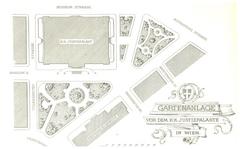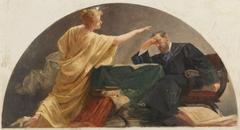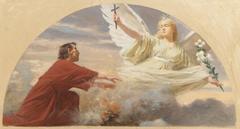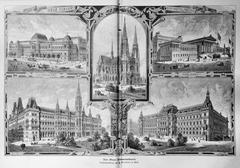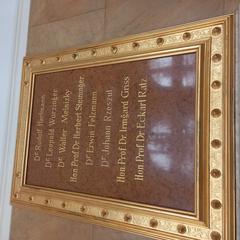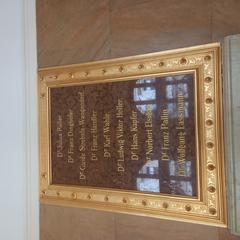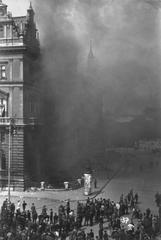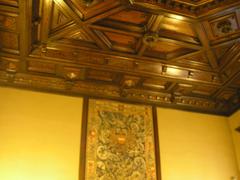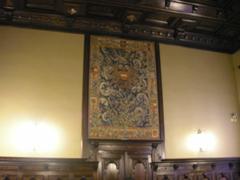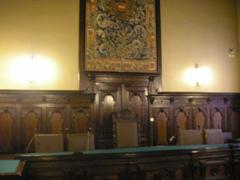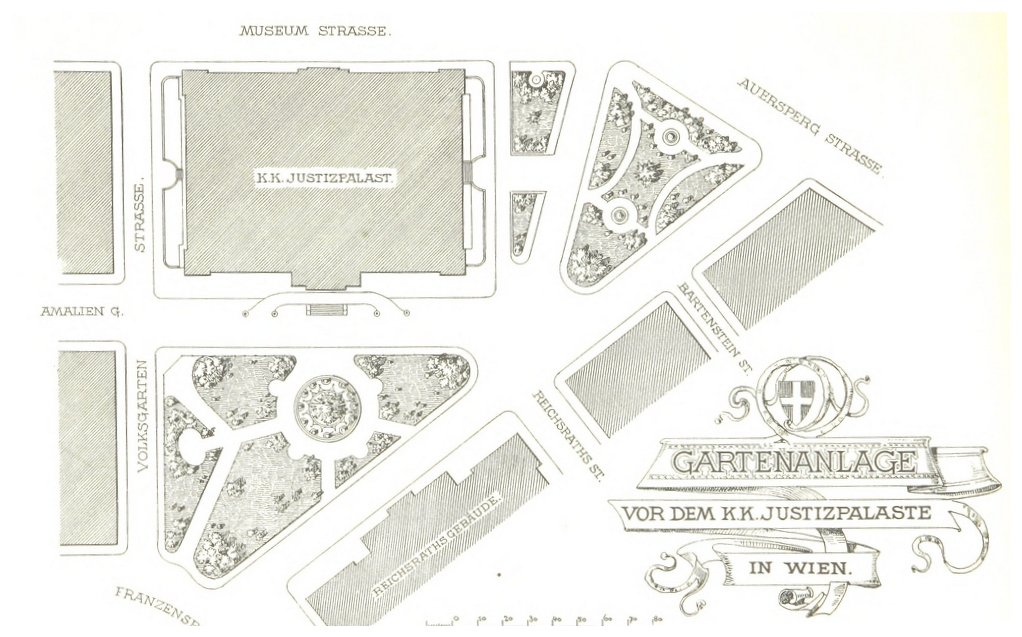
Palace of Justice Vienna: Visiting Hours, Tickets, and Historical Sites Guide
Date: 15/06/2025
Introduction to the Palace of Justice Vienna
The Palace of Justice (Justizpalast) is one of Vienna’s most iconic architectural and civic landmarks, located in the heart of the Innere Stadt district. Completed in 1881, this neo-Renaissance masterpiece embodies Austria’s legal tradition, architectural excellence, and the nation’s ongoing commitment to transparency and democracy. Commissioned after the 1848 revolutions, its construction was intended to symbolize judicial independence and the modernization of the Austro-Hungarian Empire. Designed by Alexander Wielemans von Monteforte, the Palace features balanced symmetry, Corinthian columns, an impressive glass dome, and allegorical sculptures that capture the Renaissance Revival style and its civic ideals (Justizpalast Wien – Offizielle Seite; Trek Zone).
The Palace’s history has been marked by pivotal moments, such as the 1927 fire during political unrest, which highlighted the fragility of democratic institutions in interwar Austria. Carefully restored, the building now combines historical integrity with contemporary functionality. Visitors are welcomed into public areas like the grand staircase and central atrium, and can enjoy occasional guided tours. Its central location near the Austrian Parliament and Rathaus makes it a must-see for anyone interested in Vienna’s historical sites (kelseyinlondon.com; Visiting Vienna).
Table of Contents
- Introduction
- Origins and Architectural Context
- Historical Milestones
- Architectural Features and Symbolism
- Visiting Hours, Tickets, and Entry
- Travel Tips and Nearby Attractions
- Justizcafé Experience
- Accessibility and Facilities
- Educational and Cultural Programs
- FAQs
- Conclusion and Visitor Tips
- References
Origins and Architectural Context
Commissioned in the wake of Europe’s 1848 revolutionary movements, the Palace of Justice was envisioned as a symbol of legal reform and the independence of the judiciary in a modernizing imperial capital. Construction began in 1875 and was completed in 1881, with Alexander Wielemans von Monteforte’s design in the neo-Renaissance style, emphasizing rationality, order, and civic pride (Justizpalast Wien – Offizielle Seite). The site, adjacent to the Ringstraße, was selected to reinforce the judiciary’s central role in Viennese society.
The Palace’s exterior is marked by a grand portico with Corinthian columns and elaborate pediments, while its interior boasts a monumental staircase, marble columns, and a soaring glass dome that fills the central atrium with natural light. The building’s decorative program includes allegorical sculptures of Justice, Law, and Truth, reflecting its civic purpose (Wien Geschichte Wiki).
Historical Milestones
Construction and Early Years
The Palace was built during a period of rapid urban expansion in Vienna. It was designed to house the Supreme Court (Oberster Gerichtshof), the Higher Regional Court (Oberlandesgericht), and other judicial offices, marking a milestone in the professionalization of Austria’s legal system. The interior, with its grand staircase and central glass dome, became a symbol of openness and the ideals of justice (Wien Geschichte Wiki).
The 1927 Fire and Political Upheaval
On July 15, 1927, following a controversial court verdict, the Palace became the epicenter of political unrest. Demonstrators set the building on fire, destroying much of its interior and invaluable legal archives. The event, which resulted in numerous casualties due to the government’s harsh response, underscored the deep divisions and instability of interwar Austria (Wien Geschichte Wiki).
Reconstruction and Modernization
The Palace was meticulously restored between 1927 and 1930 under Heinrich Karl Hofmann, preserving its neo-Renaissance character while adding modern safety features. Despite minor damage during World War II, the building retained its function as the seat of Austria’s highest courts, symbolizing resilience and the enduring rule of law (Justizpalast Wien – Offizielle Seite).
Architectural Features and Symbolism
The Palace of Justice is renowned for its harmonious proportions, rich ornamentation, and symbolic details:
- Grand Facade: The Schmerlingplatz-facing facade features Corinthian columns, pediments, and statues representing justice and law (The Arch Space).
- Central Atrium: An octagonal glass-domed atrium floods the interior with light, symbolizing transparency.
- Grand Staircase: Marble balustrades and gilded accents lead to upper galleries, accentuating the building’s ceremonial heart.
- Allegorical Decorations: Sculptures and murals celebrate legal virtues and Austria’s judicial heritage.
The Palace shares stylistic traits with other Ringstraße landmarks, such as the State Opera and Kunsthistorisches Museum, reflecting Vienna’s late 19th-century grandeur (Trek Zone; The Arch Space).
Visiting Hours, Tickets, and Entry
Visiting Hours:
- Monday to Friday: 7:30 am – 3:30 pm
- Closed on weekends and public holidays (ibnbattutatravel.com).
Tickets:
- Entry to public areas (including the grand staircase and atrium) is free.
- Special tours or educational programs may require advance booking.
Entry Procedure:
- Visitors pass through airport-style security. Bag checks and restrictions on large luggage or sharp objects apply (Justiz.gv.at).
Photography:
- Permitted in public areas; flash and filming are restricted, especially during court sessions.
Travel Tips and Nearby Attractions
Getting There:
- Subway: Volkstheater station (U2, U3)
- Tram: Lines 46, 1, 2, D, 71
- Bus: Line 48A
- Address: Schmerlingplatz 10-11, 1010 Wien
Nearby Attractions:
- Austrian Parliament Building
- Rathaus (City Hall)
- Volksgarten
- MuseumsQuartier
- Kunsthistorisches and Natural History Museums
Combine your visit to the Palace with these sites for a comprehensive cultural experience (Visiting Vienna).
Justizcafé Experience
The fifth-floor Justizcafé is a visitor favorite, offering affordable meals, coffee, and panoramic terrace views over Vienna’s historic rooftops, including the Parliament and Rathaus. It’s open during Palace hours and accessible by elevator. No reservation is needed, but it can be busy at lunchtime (Visiting Vienna).
Accessibility and Facilities
- Wheelchair Access: Elevators and ramps are provided in public areas.
- Restrooms: Available, signage primarily in German.
- Assistance: Staff often speak English. Service animals are permitted (Justiz.gv.at).
Educational and Cultural Programs
- Mock Trials: Offered for students by advance arrangement.
- Public Lectures: Occasionally held, open to visitors by registration.
- Exhibitions: Highlighting landmark Austrian legal cases (Awesome Vienna).
Frequently Asked Questions (FAQ)
Q: What are the Palace of Justice Vienna visiting hours?
A: Monday to Friday, 7:30 am – 3:30 pm. Closed weekends and holidays.
Q: Is there an entrance fee?
A: No, entry is free.
Q: Are guided tours available?
A: Educational programs and special tours by advance booking; general guided tours are rare.
Q: Is the Palace accessible?
A: Yes, elevators and ramps provide access to public areas.
Q: Can I take photos inside?
A: Photography is allowed in public areas, not in courtrooms or during hearings.
Q: How do I get there?
A: Use public transport to Volkstheater station or nearby tram and bus stops.
Conclusion and Visitor Tips
The Palace of Justice Vienna is a living testament to Austria’s legal tradition, architectural splendor, and civic ideals. Its neo-Renaissance architecture, turbulent history, and central location make it a must-visit for history enthusiasts and travelers alike. Make the most of your visit by:
- Checking the official website for the latest visitor information.
- Arriving early on weekdays for a quieter experience.
- Exploring the Justizcafé and combining your trip with nearby landmarks.
- Respecting the working environment of an active courthouse.
For more travel tips and updates, download the Audiala app, follow us on social media, and explore our guides to Vienna’s historical sites.
References and Further Reading
- Justizpalast Wien – Offizielle Seite
- Wien Geschichte Wiki – Justizpalast
- Wien Geschichte Wiki – Justizpalastbrand 1927
- Trek Zone – Palace of Justice Vienna
- The Arch Space – Renaissance Revival Style
- kelseyinlondon.com – Best Things to Do in Vienna
- Visiting Vienna – Justizpalast
- ibnbattutatravel.com – Palace of Justice Vienna
- Wikipedia – Palace of Justice, Vienna
- Historic Hotels of Europe – Palace of Justice Vienna
- Awesome Vienna – Palace of Justice
